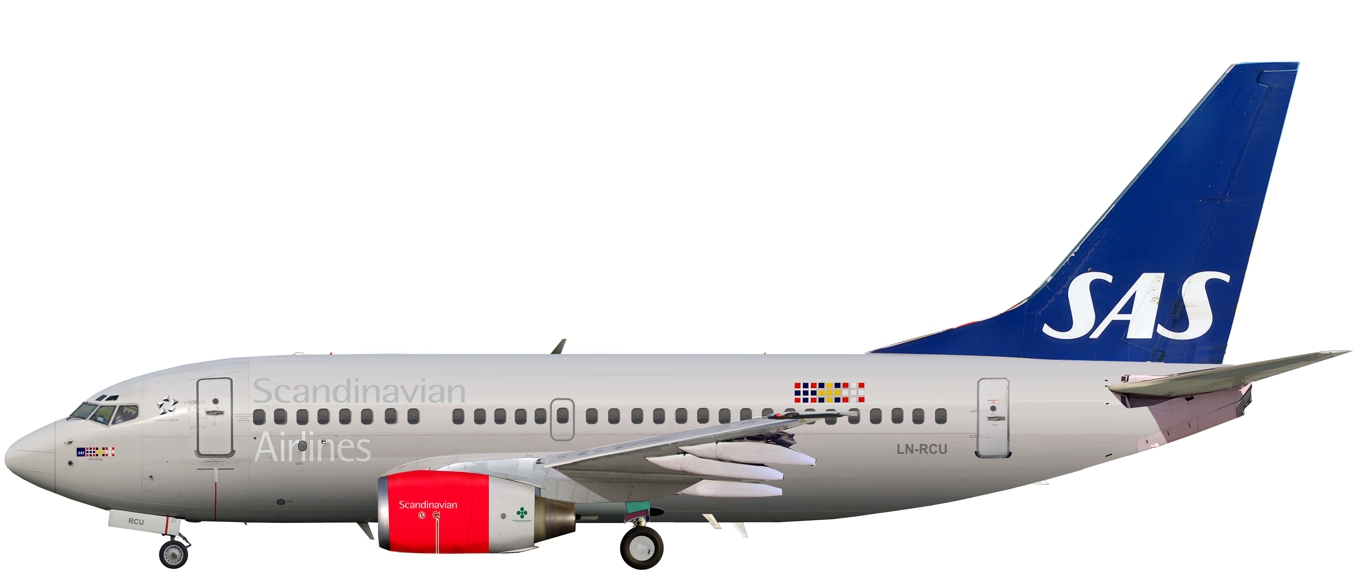
Boeing 737 New Generation . .................................Specifications

With the "New Generation" 737 series Boeing created a 737
capable of cruising at a greater height then previous
versions, thus sving fuel.
Boeing redesigned the wings and they were married to improved CFM56-7B engines.
All NG 737's, appart from the 600, were built with winglets. These also give
extra range with a smilar fuel load. This example, a series 800 with winglets
flies for Turkish Airlines (THY). The 800 is slightly longer than the 737
Classic 400 series the aircraft it is designed to replace and incorperates the
same tail skid under the tail plane, a feature first introduced on the Boeing
757. Note also the missing upper cockpit windows, a familiar feature on boeing
passenger aircraft since the 707. How ever some airlines prefer to include these
windows in the cockpit lay-out. THY has a fleet featuring both variations.
TC-JFV was delivered new by Boeing to THY in the year 2000. She is seen here in
her resplendent Manchester United livery as she was seen at Istanbul Ataturk
airport during September 2010.
Prompted by the development of the Airbus
A320, which incorporated ground-breaking technologies such as
fly-by-wire, in 1991 Boeing initiated
development of an updated series of aircraft.
After working with potential customers, the 737 Next Generation (NG)
program was announced on November 17, 1993.
The 737NG encompasses the −600, −700, −800 and −900 variants, and is to date the
most significant upgrade of the airframe. The performance of the 737NG is
essentially that of a new airplane, but important commonality is retained from
previous 737 generations. The wing was modified, increasing its area by 25% and
span by 16 ft (4.88 m), which increased the total fuel capacity by 30%. New
quieter and more fuel-efficient CFM56-7B engines were used.
These improvements combine to increase the 737's range by 900 nmi, permitting
transcontinental service. A flight test program was operated by 10 aircraft: 3
-600s, 4 -700s, and 3 -800s.The passenger cabin of the 737 Next Generation
improved on the previous style interior of the Boeing 757-200 and the Boeing 737
Classic by incorporating select features from the 777, with larger, more rounded
overhead bins and curved ceiling panels. The interior of the 737 Next Generation
also became the standard interior on the Boeing 757-300, and subsequently became
optional on the 757-200.In
2010, the interior of the 737 Next Generation was updated to look similar to
that of the Boeing 787. Known as the Boeing
Sky Interior, it introduces new
pivoting overhead bins (a first for a Boeing narrowbody aircraft), new
sidewalls, new passenger service units, and LED mood lighting. The Sky Interior
cannot be retrofitted onto existing aircraft; however, similar aftermarket
packages to simulate the look of the Sky Interior, including similar pivoting
overhead bins for existing 737 and 757 aircraft are available from components
provider Heath Tecna. Boeing's Space Bins carry 50% more than the pivoting bins,
allowing a 737 to hold 174 carry-on bags.The
first NG to roll out was a −700, on December 8, 1996. This aircraft, the 2,843rd
737 built, first flew on February 9, 1997 with pilots Mike Hewett and Ken
Higgins. The prototype −800 rolled out on June 30, 1997 and first flew on July
31, 1997, piloted by Jim McRoberts and again by Hewett. The smallest of the new
variants, the −600 series, is identical in size to the −500, launching in
December 1997 with an initial flight occurring January 22, 1998; it was granted
FAA certification on August 18, 1998.In 2004, Boeing offered a Short Field
Performance package in response to the needs of Gol Transportes Aéreos, who
frequently operate from restricted airports. The enhancements improve takeoff
and landing performance. The optional package is available for the 737NG models
and standard equipment for the 737-900ER.In
July 2008, Boeing offered Messier-Bugatti-Dowty's new carbon brakes for the
Next-Gen 737s, which are intended to replace steel brakes and will reduce the
weight of the brake package by 550–700 pounds (250–320 kg) depending on whether
standard or high-capacity steel brakes were fitted. A weight reduction of 700
pounds (320 kg) on a Boeing 737-800 results in 0.5% reduction in fuel burn.
Delta Air Lines received the first Next-Gen 737 model with this brake package, a
737-700, at the end of July 2008.On August 21, 2006, Sky News alleged that
Boeing's Next Generation 737s built from 1994 to 2002 contained defective parts.
The report stated that various parts of the airframe produced by Ducommun were
found to be defective by Boeing employees but that Boeing refused to take
action. Boeing said that the allegations were "without merit". However, a
one-year investigation by Al Jazeera's People & Power series in 2010 questions
the safety of some structural parts in 737s.

EL AL 737-900ER. This version of the 737 is the longest in the 737 family, designed to replace the Boeing 757. EL AL uses the aircraft on the Tel Aviv to Amsterdam Schiphol route, a route flown previously by 747 and 757 aircraft. This example, 4X-EHB a 737-958ER is shown as she appeared at Amsterdam Schiphol on the 3rd of September 2014.

The Boeing 737-600 is the replacement from the "New Generation" (NG) for the 737 "Classic" series 500. SAS has the largest fleet of these aircraft, world wide. These aircraft, as with all NG 737 models are built with or with out cock-pit upper windows. This particular aircraft was delivered with these cock-pit windows and has since had them removed. The series 600 did not feature winglets. LN-RCU is shown here as she appeared at Manchester Airport during 2007.

This 737 is a series 700 of Alaska Airlines and was delivered in November 1999. The winglets were added in 2007. Slightly longer than the series 600, there was no equivilent aircraft in the 737 "Classic" range of models. She is seen as she appeared at Las Vegas - McCarren International on the 26 of November 2013.